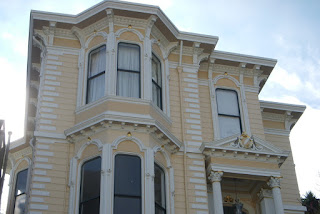 |
| Like many Colonial-era homes, the Nicholas Tyler Laundry in Colonial Williamsburg features clapboard siding. (Image courtesy colonialwilliamsburghotels.com) |
While wood siding is no longer the bargain it once was, its popularity has hardly diminished. Here’s a rundown of some of the most popular styles of horizontal siding (vertical siding would be a whole 'nother essay):
 |
| Drop siding was used to emulate the look of coursed stone, as in this classic Italianate home in San Francisco. Note the "quoins" or false cornerstones meant to further the look of stone. |
• Channel rustic is variation of board siding. It has a tall lip that engages a shallow groove in the piece above, leaving an exposed horizontal channel. It’s also known as “board-and-gap” due to the pronounced shadow effect this produces. Channel rustic made a brief comeback during the early postwar years, when its emphatically horizontal shadow line made it a natural for the low-slung Rancher homes of the era.
• Tongue and groove is yet another, more weatherproof refinement of board siding. It has a narrow tongue running along the middle of the upper edge which engages a corresponding groove above, exactly as wood flooring does. “V-groove” tongue and groove—bear with me here—has a beveled edge along the joint line that produces a heavier shadow than the plain variety.
 |
| This circa 1915 plan book house uses bungalow siding—a beefier version of bevel siding—below the porch rail, and finely-textured "3-lap" siding above. |
• Bevel siding has a tapered profile, and comes with one face smooth and the other rough sawn. You can choose whichever side suits you. Common on Colonial Revival homes, it came back for a long encore during the Craftsman period, which demanded a shaggy, natural look. In fact, a slightly beefier version known as “bungalow siding” was offered during these years, and was typically installed with the rough-sawn face exposed
 |
| Bevel siding mixed with shingle siding on the porch gable—but that's another story. (Image courtesy LA Places) |
• "Three-lap" is yet another variant of bevel siding that was popular in the early twentieth century; here, a single piece of siding was milled to look like three narrow pieces, giving a fine texture without the extra installation labor.
• Imitations of many of the above profiles made of various formulations of particleboard or hardboard are also offered by manufacturers of “engineered wood products”. These sidings are reasonably durable as long as their dense surface layer remains intact—but once this surface is broken, it’s sawdust city.
No comments:
Post a Comment